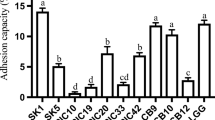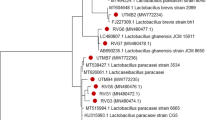Abstract
In this study, the thirty-two investigated Propionibacterium spp. strains were examined for their abilities to survive at pH 2.0, 3.0, 4.0 and 5.0 and in the presence of 0.06, 0.15 and 0.30 % bile salts, their influence on the growth of pathogens, as well as their sensitivity against eleven selected antibiotics. P. freudenreichii subsp. freudenreichii IT4, IT16, and P. jensenii MP12, BSM8 and DY1 strains survived in both the acidic and bile salt environments. Among thirty-two tested Propionibacterium spp. strains, five strains demonstrated strong and broad inhibitory spectrum against pathogen strains, and all of the Propionibacterium spp. strains strongly inhibited growth of the Escherichia coli ATCC 11229. Propionibacterium spp. strains demonstrated resistance to streptomycin, gentamycin, kanamycin, rifampicin and polymyxin B antibiotics. Overall, Propionibacterium spp. strains showed high antibacterial activity, tolerance to pH 4.0 and 5.0 and high tolerance to bile salts and will present an alternative source to Lactobacillus and Bifidobacterium for future probiotic development. In addition, culture metabolites of these strains may be used as a preservative in the food industry for the replacement of or reduction in the increasing use of chemical additives.
Similar content being viewed by others
References
Stackebrandt E, Cummunis CS, Johnson J (2006) Family Propionibacteriaceae: The genus Propionibacterium. In: Dworkin M, Rosenberg E, Schleifer KH, Stackebrandt E (eds) The prokaryotes. Springer, Singapore, pp 400–418
Cousin FJ, Mater DDG, Foligné B, Jan G (2011) Dairy propionibacteria as human probiotics: a review of recent evidence. Dairy Sci Technol 91:1–26
Woskow SA, Glatz BA (1991) Propionic acid production by a propionic acid-tolerant strain of Propionibacterium acidipropionici in batch and semicontinuous fermentation. Appl Environ Microbiol 57:2821–2828
Hugenholtz J, Hunik J, Santos H, Smid E (2002) Nutraceutical production by propionibacteria. Lait 82:103–112
Cleveland J, Montville TJ, Nes IF, Chikindas ML (2001) Bacteriocins: safe, natural antimicrobials for food preservation. Int J Food Microbiol 71:1–20
Holo H, Faye T, Brede DA, Nilsen T, Ødegård I, Langsrud T, Brendehaug J, Nes IF (2002) Bacteriocins of propionic acid bacteria. Lait 82:59–68
Lind H, Jonsson H, Schnürer J (2005) Antifungal effect of dairy propionibacteria—contribution of organic acids. Int J Food Microbiol 98:157–165
Tharmaraj N, Shah NP (2009) Antimicrobial effects of probiotic bacteria against selected species of yeasts and moulds in cheese-based dips. Int J Food Sci Technol 44:1916–1926
Warminska-Radyo I, Laniewska-Moroz L, Babuchowski A (2002) Possibilities for stimulation of Bifidobacterium growth by propionibacteria. Lait 82:113–121
FAO, WHO (2006) Probiotics in food: health and nutritional properties and guidelines for evaluation. FAO Food and Nutrition Paper
Narayan SS, Jalgaonkar S, Shahani S, Kulkarni VN (2010) Probiotics: current trends in the treatment of diarrhea. Hong Kong Med J 16:213–218
Zárate G, Pèrez Chaia A, González S, Oliver G (2000) Viability and beta-galactosidase activity of dairy propionibacteria subjected to digestion by artificial gastric and intestinal fluids. J Food Prot 63:1214–1221
Zárate G, Morata DE, Ambrosini VI, Chaia AP, González SN (2002) Adhesion of dairy propionibacteria to intestinal epithelial tissue in vitro and in vivo. J Food Prot 65:534–539
Onal Darilmaz D, Beyatli Y, Yuksekdag ZN (2012) Aggregation and hydrophobicity properties of 6 dairy propionibacteria strains isolated from homemade Turkish cheeses. J Food Sci 71:20–24
Myllyluoma E, Ahonen AM, Korpela R, Vapaatalo H, Kankuri E (2008) Effects of multispecies probiotic combination on Helicobacter pylori infection in vitro. Clin Vaccine Immunol 15:1472–1482
Jan G, Belzacq AS, Haouzi D, Rouault A, Métivier D, Kroemer G, Brenner C (2002) Propionibacteria induce apoptosis of colorectal carcinoma cells via short-chain fatty acids acting on mitochondria. Cell Death Differ 9:179–188
Culligan EP, Hill C, Sleator RD (2009) Probiotics and gastrointestinal disease: successes, problems and future prospects. Gut Pathogens 1:1–19
Yuksekdag ZN, Aslim B (2010) Assessment of potential probiotic- and starter properties of Pediococcus spp. isolated from Turkish-type fermented sausages (sucuk). J Microbiol Biotechnol 20:161–168
Onal Darilmaz D, Beyatli Y (2012) Acid-bile, antibiotic resistance and inhibitory properties of propionibacteria isolated from Turkish traditional home-made cheeses. Anaerobe 18:122–127
De Man C, Rogosa M, Sharpe ME (1960) A medium for the cultivation of lactobacilli. J Appl Bacteriol 23:130–135
Malik AC, Reinbold GG, Vedamuthu ER (1968) An evaluation of the taxonomy of Propionibacterium. Can J Microbiol 14:1185–1191
CLSI: Clinical and Laboratory Standards Institute (2005) Performance standards for antimicrobial susceptibility testing, 12th Informational Supplement M100-S12 CLSI: Wayne Pennsylvania Document M-100-S9
Alp G, Aslim B (2010) Relationship between the resistance to bile salts and low pH with exopolysaccharide (EPS) production of Bifidobacterium spp. isolated from infants feces and breast milk. Anaerobe 16:101–105
Britz TJ, Riedel KHJ (1994) Propionibacterium species diversity in Leerdammer cheese. Int J Food Microbiol 22:257–267
Carcano M, Todesco R, Lodi R, Brasca M (1995) Propionibacteria in Italian hard cheeses. Lait 75:415–426
Faye T, Brede DA, Langsrud T, Nes IF, Holo H (2004) Prevalence of the genes encoding propionicin T1 and protease-activated antimicrobial peptide and their expression in classical propionibacteria. Appl Environ Microbiol 70:2240–2244
Marcoux V, Beaulieu Y, Champagne CP, Goulet J (1992) Production of Propionibacterium freudenreichii ssp. shermanii in whey based media. J Ferment Bioeng 74:95–99
Kongo JM, Malcata FX, Ho AJ, Wiedmann M (2006) Detection and characterization of Listeria monocytogenes in São Jorge (Portugal) cheese production. J Dairy Sci 89:4456–4461
Oliver SP, Jayarao BM, Almeida RA (2005) Foodborne pathogens in milk and the dairy farm environment: food safety and public health implications. Foodborne Pathog Dis 2:115–129
Onal Darilmaz D, Gumustekin Y (2012) Research on some factors influencing acid and exopolysaccharide produced by dairy Propionibacterium strains isolated from traditional homemade Turkish cheeses. J Food Prot 75:918–926
Ouwehand AC, Vesterlund S (2004) Antimicrobial components from lactic acid bacteria. In: Salmien S, Wright AV, Ouwehand A (eds) Lactic acid bacteria microbiological and functional aspects. Marcel Dekker, New York, pp 375–389
Ho PH, Luo JB, Adams MC (2009) Lactobacilli and dairy Propionibacterium with potential as biopreservatives against food fungi and yeast contamination. Appl Biochem Microb 45:414–418
Suomalainen T, Sigvart-Mattila P, Mättö J, Tynkkynen S (2008) In vitro and in vivo gastrointestinal survival, antibiotic susceptibility and genetic identification of Propionibacterium freudenreichii ssp. shermanii JS. Int Dairy J 18:271–278
Meile L, Blay GL, Thierry A (2008) Safety assessment of dairy microorganisms: Propionibacterium and Bifidobacterium. Int J Food Microbiol 126:316–320
Thierry A, Deutsch SM, Falentin H, Dalmasso M, Cousin FJ, Jan G (2011) New insights into physiology and metabolism of Propionibacterium freudenreichii. Int J Food Microbiol 149:19–27
Delgado S, Suárez A, Mayo B (2011) Identification, typing and characterisation of Propionibacterium strains from healthy mucosa of the human stomach. Int J Food Microbiol 149:65–72
Huang Y, Adams MC (2004) In vitro assessment of the upper gastrointestinal tolerance of potential probiotic dairy propionibacteria. Int J Food Microbiol 91:253–260
Goldin BR, Gorbach SL (1992) Probiotics for humans. In: Fuller R (ed) Probiotics: the scientific basis. Chapman and Hall, London, pp 355–376
Acknowledgments
This research was supported by The Scientific and Technological Research Council of Turkey, through project no. TBAG-(107T486). The authors thank University of Aksaray, Foreign Languages Department, Academic Support Group for Foreign Languages, for proofreading the manuscript.
Conflict of interest
None.
Compliance with Ethics Requirements
This article does not contain any studies with human or animal subjects.
Author information
Authors and Affiliations
Corresponding author
Rights and permissions
About this article
Cite this article
Yuksekdag, Z.N., Onal Darilmaz, D. & Beyatli, Y. Dairy propionibacterium strains with potential as biopreservatives against foodborne pathogens and their tolerance–resistance properties. Eur Food Res Technol 238, 17–26 (2014). https://doi.org/10.1007/s00217-013-2066-y
Received:
Revised:
Accepted:
Published:
Issue Date:
DOI: https://doi.org/10.1007/s00217-013-2066-y




